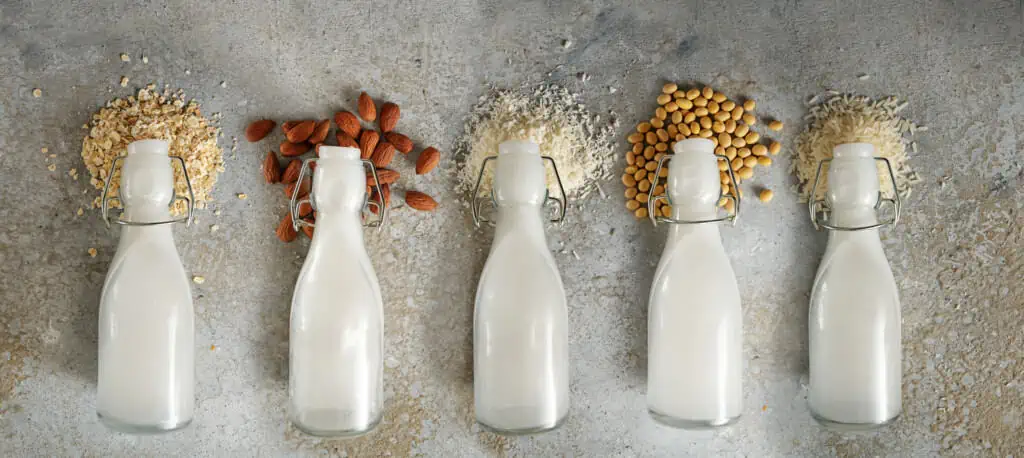
When’s the last time you walked into a coffee shop and didn’t see at least one non-dairy milk option? While oat, almond and soy milks are commonly found on café menus, there’s also a surge of other non-dairy milks — from macadamia nut to flax seed — in countless formulations designed for coffee, smoothies and other beverages. While we test hundreds of espressos each year, our standard method is to use three parts steamed whole cow’s milk to one part espresso to evaluate an espresso in cappuccino format. Of course, in that case, we’re vetting the coffee — how it performs in milk — and not the milk itself.

When we got curious about the many vegan milks we were seeing on grocery store shelves, we decided to see how they performed with espresso. But here, we’re testing the milks and not the coffees, so we simply chose three different espresso styles — classic Italian, light-roast single-origin, and natural-processed — to help us put these vegan milks through their paces. We tested 14 vegan milks that were readily available at our local Whole Foods and Safeway stores:
- Califia Farms Almond Barista Blend
- Califia Farms Unsweetened Almondmilk
- Malk Organics Unsweetened Almond Malk
- Three Trees Organic Black Sesame Almondmilk
- Forager Project Organic Cashewmilk
- 365 by Whole Foods Organic Unsweetened Coconut Original Coconutmilk Beverage
- Oatly Original Oatmilk
- Califia Farms Oat Barista Blend
- Malk Organics Oat Malk Original
- Silk Unsweetened Soymilk
- West Life Organic Unsweetened Soymilk
- Good Karma Unsweetened Flaxmilk + Protein
- Milkadamia Unsweetened Macadamia Milk
- Dream Organic Ricemilk Original Classic
Of the four almonds, three oats, two soys, and one each of cashew, coconut, flax, macadamia and rice, we landed on four vegan milks we can recommend with enthusiasm. Some of the others might work well in pour-overs or cold coffee, but they were problematic in cappuccino format. Coffee shops have their go-to brands, of course; these are products we recommend for home use.
Why Vegan Milk?
U.S. retail sales of plant-based milk rose 6.4 percent to $2.299 billion between June 2022 and June 2023, driven in part by double-digit growth in oat milk and pea milk. A study by Strategic Market Research LLP values the 2021 plant-based milk market at $35 billion and predicts that figure will increase to $123.1 billion by 2030.
While alternatives to cow’s milk are essential for those who are lactose intolerant or allergic to it, there’s also a growing number of Americans choosing vegan diets, not to mention those of us who sometimes drink cow’s milk but want to mix it up — so, there’s a growing market for alternative milk products and strong competition among producers. (Note that some vegan milks also come with heated debates about how much water consumption their production requires — almond milk, in particular. But while this is an important conversation, it is outside the scope of this report, which focuses on sensory considerations.)
Assumptions, Values and Testing Methods
Before we began our testing, Coffee Review co-cupper Jason Sarley and I discussed our criteria for what constitutes a good alt-milk product, as well as our assumptions about what we’d find. We agreed that a good vegan milk for use in espresso drinks should froth well, should integrate smoothly with the coffee, should have an appealing texture in the mouth, and should, of course, taste good combined with the coffee and have a pleasing aftertaste.
We also shared some assumptions that turned out not to be entirely true. We both expected that the purest vegan milks — those without added sugars and various gums, stabilizers and other additives — would be our favorites, but our sensory analysis did not support this. We were surprised by which alternative milks played well with the coffees, and we made some genuine discoveries.
Our evaluative categories were as follows: frothing, mouthfeel, integration, flavor and aftertaste. Because we were looking at the milks and not the coffees, we didn’t use our standard review format but rather offer here detailed sensory observations without ratings for each milk.
Espressos We Used to Test the Milks
Sticking with the theme of broad accessibility, we chose coffees from three large roasters: Illy’s Espresso Classico, La Colombe’s Early Riser Single-Origin Rwanda, and Counter Culture’s Kabeywa Natural Sundried Uganda. These coffees can be found at many grocery stores or ordered online direct from the roasters. As straight shots, these three coffees epitomize their types: classic Italian style, chocolaty and nutty (Illy); washed third wave, bright and citrusy (La Colombe); and natural-processed, fruit-forward (Counter Culture). They all worked predictably well in cappuccino-scaled milk with our usual Clover Organic whole cow’s milk. But how would they do with these vegan milks?

While we were curious to taste the vegan milks plain, we decided to do so after our testing so we wouldn’t be unduly influenced and look for particular features in the milk shot. But when we did taste the standalone milks later, we had some revelations. (See “The Also-Rans” below.)
It also became clear to us during this process that the only evaluative categories that shifted with each of the different espressos were flavor and aftertaste. Integration of coffee and milk and mouthfeel (and frothing, of course) weren’t appreciably different across coffees. Our tasting notes reflect these findings.
Four Alt-Milk Winners
Two almonds, an oat and a macadamia nut milk rose to the top in our sensory testing, excelling in almost all, if not all, of the evaluative categories. We present our tasting notes here in lieu of formal reviews, as this is our first official foray into the genre. For each of the four recommended milks, you’ll find our observations on frothing, mouthfeel and integration, followed by flavor and aftertaste with each of the three coffees. Here they are, in no particular order:
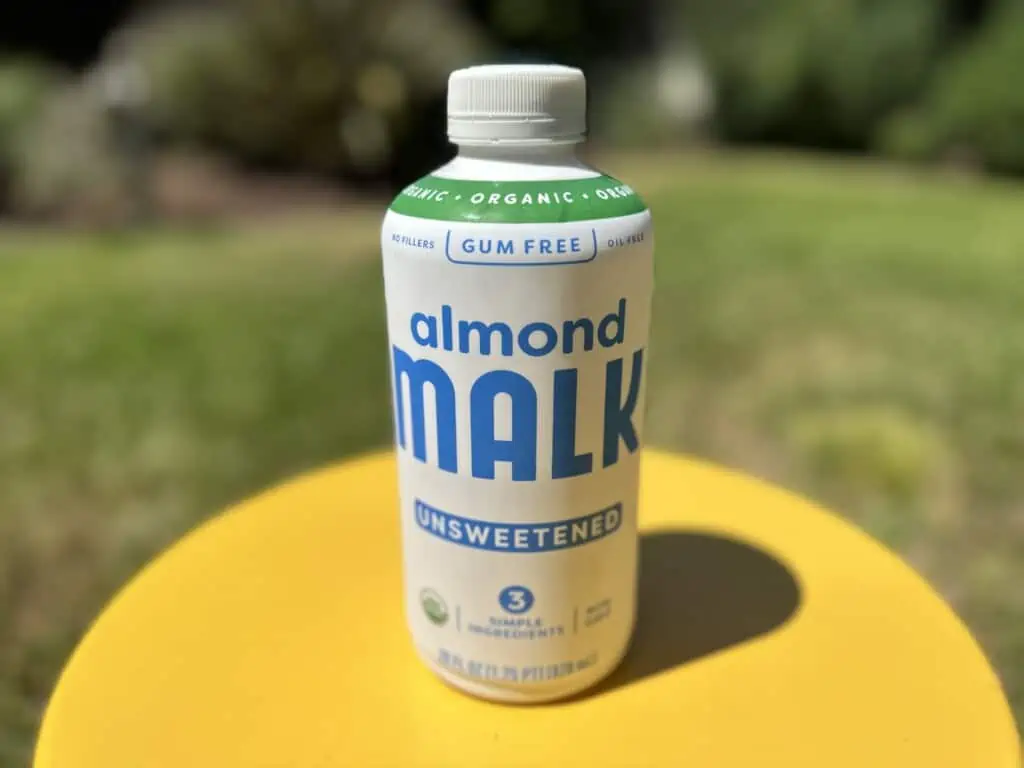
Malk Organics Unsweetened Almond Malk ($6.99/28 ounces on Amazon)
Frothing: Very thick, meringue-like – but latte art is possible! Easy to get solid peaks; producing microfoam is more challenging.
Mouthfeel: Creamy, smooth, crisp (pleasantly dry).
Integration: Not fully integrated, more like an espresso shot with a milk “cap.” Would be better in café au lait or espresso macchiato format where the milk sits on top of the espresso shot.
Flavor with Illy Espresso Classico: Unsweetened, so the coffee flavor really predominates, and the almond undertones and aromas are distinctly and recognizably almondy. The milk doesn’t obstruct the coffee. Some people will add sugar to replicate the natural sweetness of whole cow’s milk.
Aftertaste with Illy Espresso Classico: Consistent and persistent; harmonious with the coffee throughout.
Flavor with La Colombe Rwanda: Quite almondy on the nose (like a Snickers bar). In the cup, there’s more almond flavor than with the Illy, likely because this coffee’s light roast makes its flavor more subtle and nuanced, but it holds its own.
Aftertaste with La Colombe Rwanda: Consistent throughout; doesn’t outlast the coffee.
Flavor with Counter Culture Natural Uganda: The milk tamps down the exuberance of the natural-processed coffee, leaving just a whisper of delicate fruit.
Aftertaste with Counter Culture Natural Uganda: Muted, short finish.
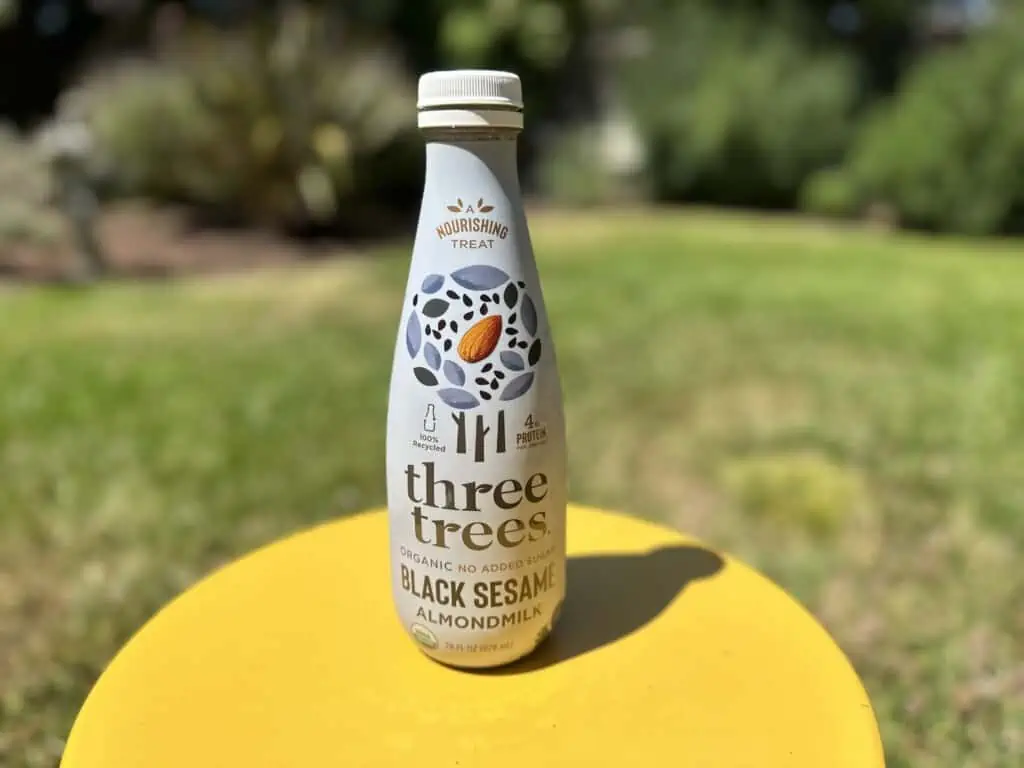
Three Trees Organic Black Sesame Almondmilk ($7.99/28 ounces on Amazon)
Frothing: Purplish in color from black sesame; decent froth but challenging for patterning or latte art (no microfoam to speak of).
Mouthfeel: Airy, frothy, lilting, nicely fatty.
Integration: Fairly well-integrated but might need to stir; a slight separation line is visible, but for all intents and purposes, the coffee and the milk blend nicely together.
Flavor with Illy Espresso Classico: Sweet like whole milk, but not overwhelmingly sweet. Notes of chocolate and hazelnut, and hints of date from the milk.
Aftertaste with Illy Espresso Classico: Moderately persistent. Lasts long enough.
Flavor with La Colombe Rwanda: Jason and I were split on this one. I found the coffee and milk pleasantly juxtaposed; nice tart/sweet combo. Jason thought the added date in the milk (see the ingredients section below) competed with the fruit of the coffee. Better with the Illy because this Rwanda is distinctive and the Illy is classic/familiar.
Aftertaste with La Colombe Rwanda: Moderately persistent.
Flavor with Counter Culture Natural Uganda: Absolutely the right fruit combo – alcohol leaning, dried raspberry/cherry/date mélange works beautifully. This is like a dessert, elegant and opulent.
Aftertaste with Counter Culture Natural Uganda: Seamless, long, flavor-saturated.
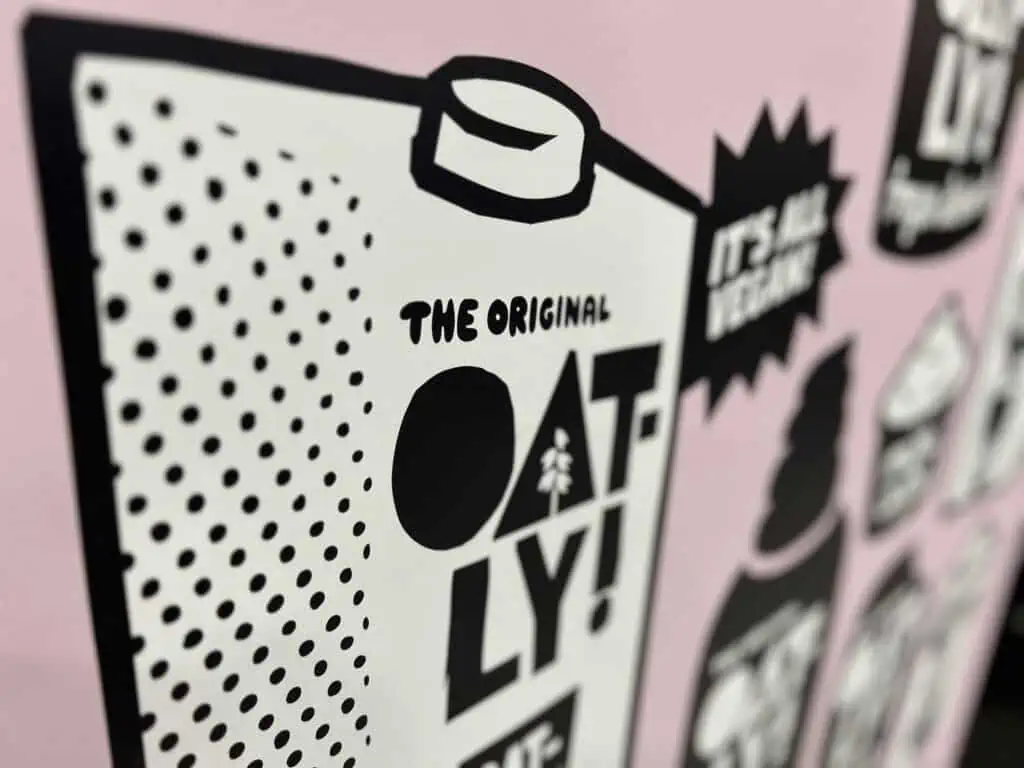
Oatly Original Oatmilk ($5.99/64 ounces on Amazon)
Frothing: If you’re a home latte artist, you’re in luck! This was our best-performing frother. Foam is delicate but persistent; good microfoam, conducive to latte art. (See the ingredients section for information about sugars created during processing.)
Mouthfeel: Lush, syrupy (low impact); quite viscous.
Integration: Excellent; milk and coffee combine very well.
Flavor with Illy Espresso Classico: Not too overtly oaty (surprising, given our experience with this milk in coffee shops). Amplifies baking chocolate notes; pushes them up and out. Nonconfrontational.
Aftertaste with Illy Espresso Classico: Long, lingering, balanced – coffee is prominent, oat is backgrounded.
Flavor with La Colombe Rwanda: Balanced; some oat flavor, but very pleasant and not overpowering. Hazelnut, stone fruit, freesia.
Aftertaste with La Colombe Rwanda: Balanced, sweet, moderately long.
Flavor with Counter Culture Natural Uganda: The natural-processed coffee is very aromatic; the grape candy profile is only slightly tamed by milk. Oat is rather pleasantly overwhelmed by fruit. Tastes like a sweet-tart candy, also chocolaty.
Aftertaste with Counter Culture Natural Uganda: While persistence is a bit muted by the fruit-forward coffee, the milk adds a pleasing nutty counter note.
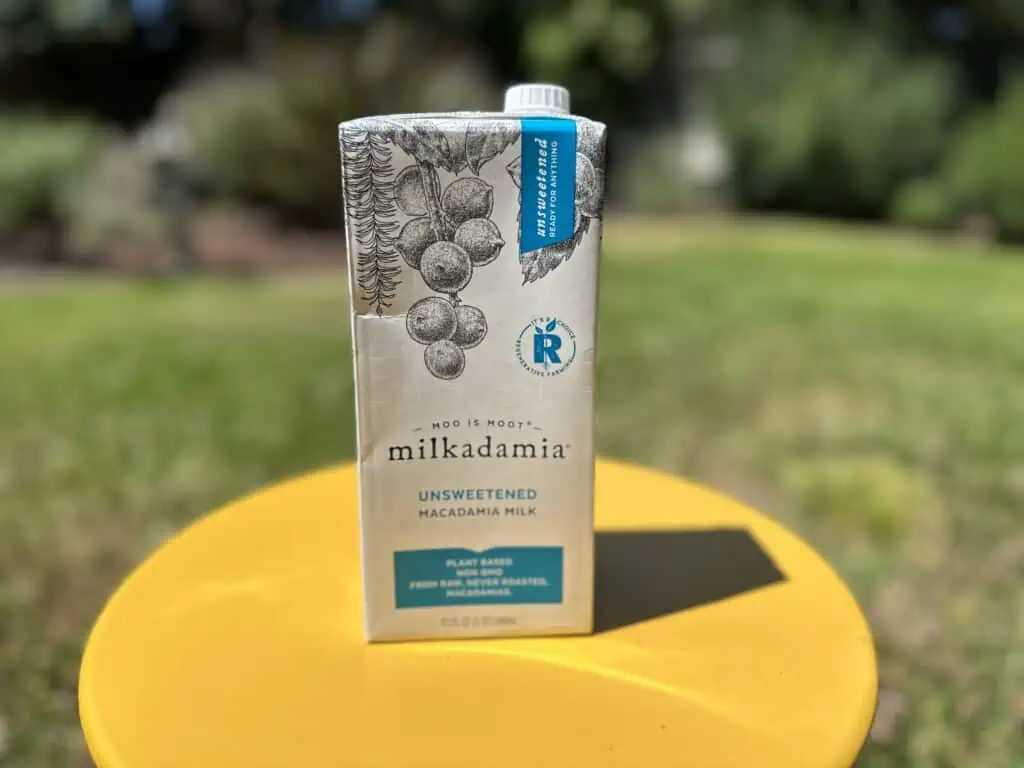
Milkadamia Unsweetened Macadamia Milk ($5.29/32 ounces on Amazon)
Frothing: No froth whatsoever, so neither latte art nor a proper cappuccino is possible. (This might not matter so much for home use.)
Mouthfeel: Very smooth, lightly syrupy.
Integration: Very good, long-lasting integration of coffee and milk.
Flavor with Illy Espresso Classico: Ever so slightly naturally sweet, despite no added sugar – supports and highlights the coffee, doesn’t compete. Chocolate, hazelnut predominate in the cup.
Aftertaste with Illy Espresso Classico: Quiet, rather muted but pleasant.
Flavor with La Colombe Rwanda: Sweet in the nose but less so on the palate. Nutty sweet over (not under) the coffee, but coffee comes through underneath. Not a bad combo, but not harmonious either. Better with the Illy than with this lighter-roasted single-origin.
Aftertaste with La Colombe Rwanda: Very strong; overpowers the delicate coffee in the finish.
Flavor with Counter Culture Natural Uganda: Terribly discordant. (Jason aptly describes this combo as akin to trying on too many fragrances at the perfume store simultaneously.) Milk’s perfume and coffee’s fruit compete.
Aftertaste with Counter Culture Natural Uganda: Not harmonious; flavors fight.
Ingredients of Recommended Milks
After we worked our way through all 14 milks with the coffees, we decided to taste the milks by themselves. Of course, during the process, we got interested in the ingredients of each milk in terms of how the processing and presentation reflected in our experience of the milks as bases for the cappuccino format. In this section, we report only on the four milks we are recommending, but you can find our sensory notes on the remaining 10 alt-milks in the section titled “The Also-Rans.”
Jason and I both thought we’d prefer the vegan milks with no added sugars or gums, but we tried a wide range — both sugar- and gum-free and sugar- and gum-laden. The four milks that rose to the top of our sensory rankings include both types.
Malk Organics Unsweetened Almond Malk
Ingredients: Filtered water, organic almonds, Himalayan pink salt.
The success of this milk as a base for cappuccino was a surprising discovery for us. Both Jason and I thought it would lack the oomph needed to stand up to coffee. Tasted alone, it’s sweetly almondy, quite delicate. (The salt amps the sweetness of the almonds.) But it worked well with the classic Illy espresso, as well as the La Colombe Rwanda. We can’t really explain why this delicate milk muted the Counter Culture natural Uganda except to say the drink became a nut tsunami in this particular context. It wasn’t predictable, but it was irrefutable.
Three Trees Organic Black Sesame Almondmilk
Ingredients: Filtered water, organic almonds, organic black sesame seeds, organic dates, pink Himalayan salt.
This milk has 8 grams of added sugar per cup in the form of dates. We both loved its rich nuttiness and creamy mouthfeel, and when we realized that our go-to cow’s milk for testing espressos at the Coffee Review lab (Clover Organic Whole Milk) has 12 grams of natural sugars, it made sense that the sugar from dates would potentially work. This milk contains no gums, yet it frothed well nonetheless.
Oatly Original Oatmilk
Ingredients: Oat base (water, oats). Contains 2% or less of: low erucic acid rapeseed oil, dipotassium phosphate, calcium carbonate, tricalcium phosphate, sea salt, dicalcium phosphate, riboflavin, vitamin A, vitamin D2, vitamin B12.
Put simply, this is the kind of milk we didn’t want to like, full of additives whose functions the average consumer wouldn’t be able to readily interpret. But dang if it didn’t taste great with all three coffees. (This is a milk you’ll often find in coffee shops, and now we know why. It does its job of marrying well with espresso drinks.)
Note: The label states that this product has 7 grams of added sugars, but the website explains that these sugars are created in the production process when enzymes are used to liquefy the oats, resulting in a breakdown of the starches into smaller components including simple sugars. The FDA now requires this kind of process to be indicated under “added sugars.”
Milkadamia Unsweetened Macadamia Milk
Ingredients: Macadamia milk (filtered water, macadamias), calcium phosphate, guar gum, natural flavors, pea protein, sunflower lecithin, sea salt, gellan gum, zinc sulfate, vitamin A acetate, vitamin D2, riboflavin (B2), vitamin B12.
Pure, unadorned macadamia nuts are sweet and creamy, which makes them sound like a potentially good pairing with espresso. So, it’s a bit of a mystery why so many additives are needed to produce this milk, but we call it like we taste it, and it works well with two of the three espressos we tested. (It was spot-on with the Illy classic espresso and the La Colombe Rwanda.) As a standalone milk, its aroma is very sweet. But wait, it has zero grams of sugar! Jason hypothesizes that the “natural flavors” involve some kind of agent that essentially perfumes the milk. And, in fact, it bombed with the natural-processed Counter Culture Uganda, which has enough personality on its own. Still, we recommend it — with caveats — for its flavor with most espressos. Besides the issue of perfuminess, the other caveat is that it doesn’t froth at all, so you can decide how much you care about that. Otherwise, the texture is pleasing.
The Also-Rans
Here’s a rundown of the milks we don’t recommend for use in the espresso-based milk drinks you make at home. Note that not all of these milks are intended for use in espresso drinks, an our comments only apply to that application, though we do mention when we think a particular brand might work well with drip coffee or cold brew.
Califia Farms Almond Barista Blend
Frothing: Calcium carbonate added to make it “foam,” but it’s fake foam, i.e., it flattens right away. Visually unappealing. Bubbly.
Mouthfeel: Creamy but tacky/gummy/dry.
Integration: Separates quickly.
Flavor: Bittersweet milk shot. Somewhat nutty, but not overtly almondy. Calcium carbonate is easily tasted, a big turnoff.
Aftertaste: Long, a bit cloying.
Califia Farms Unsweetened Almondmilk
Frothing: Bubbly with persistence; fat bubbles.
Mouthfeel: Tacky.
Integration: Denser solids sink to bottom, bubbles float on top.
Flavor: Bitter, weirdly perfumy, chemical-sweet. Overpowers a pretty bold coffee.
Aftertaste: Very long and quite bitter.
Forager Project Organic Cashewmilk (with oat)
Frothing: Very impressive! Good microfoam, easy to pattern for latte art.
Mouthfeel: Light, silky, somewhat heavy.
Integration: Excellent integration, only a small amount of separation.
Flavor: Aroma doesn’t seem overly nutty, but strong cashew flavor competes in the cup. Sweet and inviting unheated, but sours as it steams. Could be good for cold coffee (unsteamed).
Aftertaste: Gets dry and bitter in the long.
365 by Whole Foods Organic Unsweetened Coconut Original Coconutmilk Beverage
Frothing: Virtually none.
Mouthfeel: Silky, very light.
Integration: None.
Flavor: Bland, mildly coconutty. Really butted heads with each coffee.
Aftertaste: Persistent.
Califia Farms Oat Barista Blend
Frothing: Frothed well.
Mouthfeel: Slightly gooey and a bit sharp.
Integration: Integrated well with the coffee.
Flavor: Sharp taste in addition to oat.
Aftertaste: Sharpness in the long finish underneath the oat.
Malk Organics Oat Malk Original
Frothing: Doesn’t froth well.
Mouthfeel: Dry, foamy.
Integration: Integrates well with coffee.
Flavor: Oaty!
Aftertaste: Long, cloying (unless you really like oat milk).
Silk Unsweetened Soymilk
Frothing: Decent froth.
Mouthfeel: Silky-smooth.
Integration: Poor.
Flavor: Medicinal, sharp, overpowering.
Aftertaste: Sharp, bitter, dry.
West Life Organic Unsweetened Soymilk
Frothing: Fair, but latte art would be challenging.
Mouthfeel: Very thin, watery.
Integration: Combines well with coffee.
Flavor: No perceptible soy aroma, but it moves the coffee toward its own bitter edges.
Aftertaste: Quiet.
Good Karma Unsweetened Flaxmilk + Protein
Frothing: None.
Mouthfeel: Sharp.
Integration: None.
Flavor: Vegetal, medicinal.
Aftertaste: Vegetal, medicinal, dry.
Dream Organic Ricemilk Original Classic
Frothing: No froth.
Mouthfeel: Very smooth.
Integration: Good integration, seamless.
Flavor: Too sweet.
Aftertaste: Very long.
We learned a lot during this exercise and look forward to more experimentation as new products come on the market. Whether you’re a committed vegan or just alt-milk curious, there is an increasing number of products available for you to experiment with in your at-home espresso ritual.










